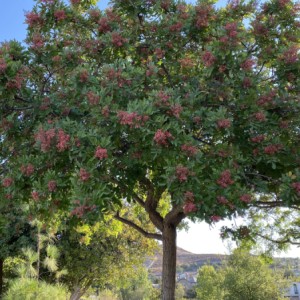BRAZILIAN PEPPERTREE: SCHINUS terebinthifolia
Many years ago, when we first moved to California, we moved into a new house, then designed our gardens. We hired a landscaper who really knew his plants, but was a bit of a curmudgeon. I had all kinds of ideas about
the trees I wanted, but he educated me on the dangers of messy plants.
He refused to plant a CALIFORNIA PEPPER, ("too messy!"), but he suggested the BRAZILIAN PEPPER instead. We found the perfect specimen, & he planted it as focal point in our back yard. In 8 years time, it grew into such an interesting tree, & I forgave him for denying me a
MIMOSA TREE ('too messy!')
On my walk today, I saw a small grouping of BRAZILIAN PEPPERTREES, just as the TINY peppercorns have turned red. In the EXTRA there is
the prettiest of the bunch. This tree is considered invasive in some areas but I found my tree to be very well behaved. (NOT messy!)
It is banned in Florida & Texas.
When I returned home I did some research & learned this tree is native to South America & is also called Christmasberry Tree & Florida Holly.
The flowers are the main source of food for a variety of honey bees.
Like the California Pepper, the seeds are not true peppers, but can be used as a spice & are sometimes pickled.
All parts of the tree have been used medicinally by indigenous people
throughout the tropics. A liquid extract can be prepared from the bark, for a variety of ailments. The berries have shown promise as a treatment for the superbug, MRSA, because it appears to stop the bacteria from producing a toxin; & it suppresses the way the bacteria communicates.
When I was taking this Blip, I saw a trail up the mountain, in the distance.
We took that trail in the early part of the Summer. Now that it may be cooling off, it might be a good time to do it again. The views are great!


Comments
Sign in or get an account to comment.


